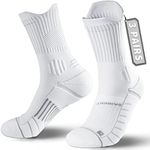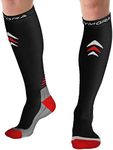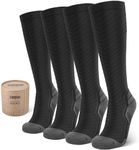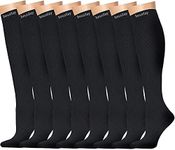Buying Guide for the Best Compressions Socks
Compression socks are designed to improve blood flow, reduce swelling, and provide support to your legs. They are commonly used by athletes, people with certain medical conditions, and those who spend long hours on their feet. Choosing the right pair of compression socks involves understanding various specifications and how they align with your needs. Here are some key specs to consider when selecting compression socks.Compression LevelCompression level refers to the amount of pressure the socks apply to your legs, measured in millimeters of mercury (mmHg). This is important because different levels of compression are suited for different needs. Light compression (8-15 mmHg) is good for everyday wear and mild swelling. Moderate compression (15-20 mmHg) is often used for travel and mild varicose veins. Firm compression (20-30 mmHg) is typically recommended for moderate to severe varicose veins, swelling, and after surgery. Extra firm compression (30-40 mmHg) is used for severe medical conditions and should be prescribed by a doctor. Choose the compression level based on your specific needs and any medical advice you have received.
MaterialThe material of compression socks affects their comfort, durability, and breathability. Common materials include nylon, spandex, and cotton blends. Nylon and spandex provide good elasticity and durability, making them suitable for athletic use and long-term wear. Cotton blends offer more comfort and breathability, which can be better for everyday use. Consider your activity level and personal comfort preferences when selecting the material.
Size and FitSize and fit are crucial for the effectiveness of compression socks. They should fit snugly but not be too tight. Most brands provide sizing charts based on your shoe size, ankle circumference, and calf circumference. Properly fitting socks will provide the right amount of compression and stay in place without causing discomfort. Measure your legs accurately and refer to the sizing chart to find the best fit for you.
LengthCompression socks come in various lengths, including ankle, knee-high, and thigh-high. The length you choose depends on where you need the most support. Ankle-length socks are good for localized swelling and foot issues. Knee-high socks are the most common and provide support for the entire lower leg, making them suitable for most conditions. Thigh-high socks offer support for the entire leg and are used for more severe conditions or post-surgery recovery. Consider your specific needs and the areas where you experience the most discomfort or swelling.
DurabilityDurability refers to how long the compression socks will last before they lose their elasticity and effectiveness. This is important because high-quality, durable socks will provide consistent compression over time. Look for socks with reinforced toes and heels, as these areas tend to wear out the fastest. Reading reviews and checking the brand's reputation can also give you an idea of the product's durability. Choose socks that are known for their longevity, especially if you plan to wear them frequently.
Moisture-Wicking PropertiesMoisture-wicking properties help keep your feet dry by drawing sweat away from the skin. This is important for preventing blisters, odor, and fungal infections. Socks with good moisture-wicking properties are typically made from synthetic materials like polyester or blends that include spandex. If you have an active lifestyle or tend to sweat a lot, look for compression socks that advertise moisture-wicking capabilities to keep your feet comfortable and dry.
















